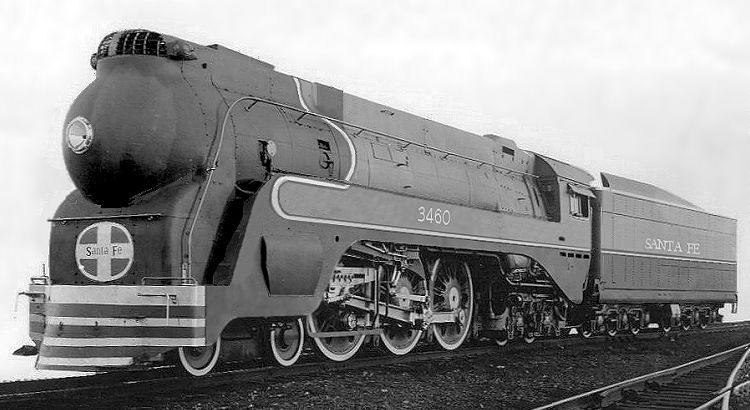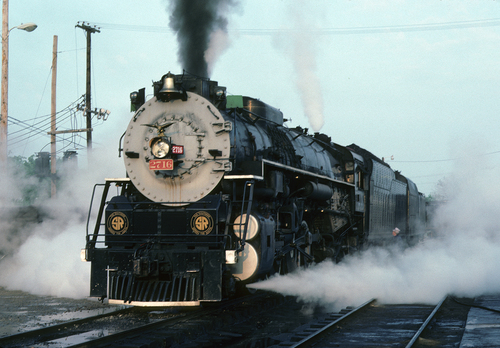When looking over what the Ripley Plan would have gotten them, the Southern decided it was a fairly sweet deal. In Florida, their reach was dramatically expanded by being able to work with the Florida East Coast. Further west, they were able to acquire a line to Nashville via the Tennessee Central railroad's eastern half, as well as trackage rights on the Nashville, Chattanooga, & St. Louis; also they gained stake in the Mobile & Ohio from its St. Louis-Mobile route, and the Chicago, Indianapolis, & Louisville from Chicago to Louisville via Monon, leaving the rest to the Baltimore & Ohio.
With the dramatically expanded network, the Southern came to realize that it would need new power to handle the workloads. To that end, they began working to have a series of new steam engines constructed.
The Ts-2/3/4 4-8-2s
Sprite art of Ts-3 #2461. Today, it is a major player in the Southern's iconic steam excursion program.
As the Southern gained more and more stake in the line, the Florida East Coast engines began to see more use all across the Southern. Though the engines were still labeled at FEC (and the company has remained semi-independent for all this time), the three classes also had their numbers changed with a 2 in front to the numbers, thus for example, 404 became 2404, or 819 was now 2819. As the age of the Ps-4 Pacifics became more apparent, the Southern worked with ALCO Richmond to create several more of the 401 type. These engines resembled their original FEC equivalents closely. But with the addition of a Southern-style headlight and their Crescent Green livery.
The Us-1 2-8-4 "Piedmonts"
#2716 is seen on an excursion during her time with the Southern excursion program. She is noticeably better dressed than during revenue days.
In the Washington-Atlanta speedway portion of the railroad, older engines were having trouble hauling the increasingly bigger freights that the economic re-growth caused. As such, the Southern opted for a 2-8-4 on the grounds of being stronger but also faster. Turning to Lima for several engines that were numbered in consistency with the former FEC Mikados. These engines were classified the Us-1 type, and would be become the primary freight hauler on lines in Eastern parts of the system. With older mikados and Santa Fes finishing their service on freight in western parts of the system.
The Vs-1 4-8-4 "Crescents"
Sprite art of #2609. Which is now part of the Southern steam Excursion program as its main star.
Likewise, the Southern also ordered several 4-8-4s from Lima. Very similar to the Soo Line's 5000 series, the engines were primarily mixed-traffic, but would be the last steamers to haul such iconic Southern trains as The Crescent from DC to Atlanta. These engines were the second most numerous Southern passenger engine, and were adorned in an even more gorgeous form of the Southern Green, as well as a gold shaped eagle above the headlight. They could be seen on just about any part of the Southern's system from Washington DC to New Orleans or the interchange with the Florida East Coast in Jacksonville.
The MMs-1 2-8-2+2-8-2 Garratt
The South African Railways GE Garratt, on which the MMs-1 was heavily based.
The Ratholde Division of the Southern was always a major bottleneck for its dire tunnel and curvature issues. The issue went beyond this, however, as the Southern was also limited to the size of the locomotives able to operate the line due to asphyxiation and heat problems. In most cases, only the smallest 2-8-2 Mikados in freight service and 4-6-2 Pacifics for passenger trains could be used. But things changed when in the 1930s, ALCO approached the Southern with the idea of constructing a garratt, which ALCO had the license for from Beyer-Peacock & Company, and both companies worked with the Southern to design them. Much like several Garratts built around the same time for Canadian National [1], these were mainly to see if they worked. However, the garratt worked wonders thanks to its ability to run just as well back-first, and several more were operated until diesels eventually arrived. Today, three are preserved with one, #7508, working on the famous steam program.
[1] Ask
@TheMann for details.


